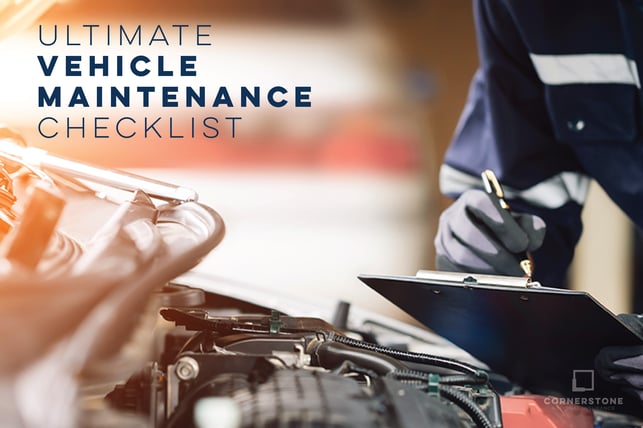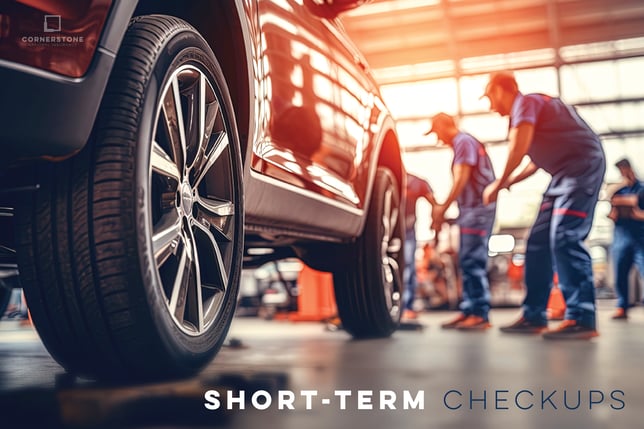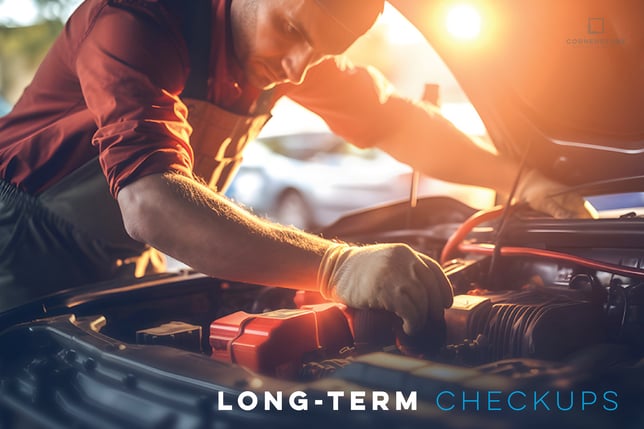
Just like we go to the doctor for regular checkups and wellness visits throughout our lifetime, our cars need the same care and attention when it comes to maintaining their overall health. Unlike us humans, though, our vehicles come with this handy booklet called an Owner's Manual - you may have heard of it? If you haven't taken yours out of the 'ol glove box in a while, consider doing so sooner rather than later.
Sure, your Owner's Manual walks you through all the cool features your car boasts, but more importantly, it's a wealth of information regarding the best care practices for your ride. From ideal tire pressure settings and oil levels to troubleshooting common technical problems, your Owner's Manual is the best source to refer to as you establish an appropriate maintenance schedule for your vehicle.
Did you know? According to Advanced Auto Parts, your Owner's Manual defines maintenance schedules into two categories: Regular and Severe. You may not think of your daily driving routine as "severe," but your car feels otherwise if you regularly experience:
- Stop-and-go traffic or idling
- Short commutes of five miles or less
- Heavier loads, including cargo, passenger, or towing
- Rough or mountainous roads
- Dusty or salty environments
- Extremely hot or below-freezing weather or a high humidity climate
If your vehicle frequently faces any of these conditions, consider following the severe maintenance schedule.
With your Owner's Manual guiding the way, there are several preventative measures you should routinely keep up with throughout the year, depending on the time and season, to maximize the life and performance of your vehicle. A solid history of maintenance not only helps you get the most out of your ride, but also ensures you get top dollar when it comes time to sell or trade it in. And of course, it’s important to remember that while car maintenance costs may not always be cheap upfront, footing those expenses now will ultimately help you avoid even greater high-dollar repairs down the road.
Here's a simple breakdown for keeping your car's health in top-notch condition.
Short-Term Checkups
Every Month - 3 Months

Oil And Coolant Levels
About every month - especially if your commutes are long or you're about to head out on an extended road-trip - it's a good idea to have your trusted, local mechanic get under the hood of your car and inspect both the oil and coolant levels. Low levels of either can lead to engine problems if left unchecked. If you feel confident enough to do this yourself, make sure your car has been shut off for a while so that the engine is cool, and refer to your Owner's Manual for help locating both on your specific vehicle.
Air Filter
Your engine’s air filter is responsible for regulating the air that flows into it, by blocking debris and particulate. If your commute includes dusty conditions, thanks to gravel roads - country dwellers know - you'll likely need to have your filter changed more often. One of the most common issues you'll encounter if you don't replace your air filter regularly is a noticeable decrease in gas mileage. By ensuring that your air filter is flowing correctly, you can improve and maintain higher fuel efficiency, decrease your emissions, and help guarantee a longer engine life.
The good news is, air filters on most engines are relatively easy to access, and you can check the location in your Owner's Manual if you need help. Open up your hood and take a look at your air filter - If you find black areas on the section through which outside air enters, it may be time for a swap.
Tire Inflation, Tread Depth, And General Condition
Proper inflation is the Holy Grail of tire maintenance, so make sure you carry a tire gauge in your glove box. You should check your tire pressure every month, before any road trips, and any time you'll be pulling extra load. Plus, keep in mind that tire pressure drops one pound with every ten degree decrease in pressure during the colder months. In addition to ministering appropriate tire pressure, it's important to regularly inspect your tread depth and general condition to get the most life out of your tires. On average, most tires are considered to have a life of between 25,000 and 50,000 miles before they need to be replaced.
Pro Tip: You can check your tread depth easily using the penny test. If the tread on your tires has been worn down to 2/32", replacing your tires isn't really an option - it's a legal requirement. If you suspect your tire tread may be dangerously low or appear to be borderline bald, it's time to do the penny test. Place a penny with Lincoln's head upside down and facing you into the shallowest groove on the tire.
Now that your penny is in your tire tread, what do you see? If you can see Lincoln's chin, nose, or eyes, you're golden. But if you can also see the top of Honest Abe's head, this means your tire treads are too shallow and worn, and it's time to replace them ASAP.
Don't forget to rotate your tires to extend their service life. Rotating your tires regularly will more evenly balance the tread wear, and help prevent noise and vibration problems when you're cruising.
Headlights/Taillights, Turn Signals, And Brake Lights
This maintenance measure is easy to keep up with, but also easy to overlook. When your head/tail lights fail, not only can it be dangerous for you and other drivers, it can also result in a citation from a police officer. Sometimes when a head/tail light lens cracks or breaks, it can allow moisture to enter the lens, cause a short circuit, blow a fuse, and result in a burned-out bulb. That's why it's important, every month or so, to visually inspect your head/tail light lenses to make sure they're not damaged. Then, have a friend stand behind your car while you apply the brakes to make sure both lights are functioning. And don't forget to turn on your headlights and engage your blinkers to see that all are working and well-positioned.
Oil And Filter
The motor oil in your car's engine serves multiple functions, from lubricating all the moving parts, acting as a sealant against debris, cooling the engine, and minimizing wear and tear to preventing engine corrosion. The oil filter is responsible for removing grit and grime from your oil, which prevents contaminants from entering the engine itself when oil circulates. So, it's critical to change the oil and filter regularly to keep your engine as healthy as possible. Depending on your car and what kind of oil you’re using, you may need to change both the oil and oil filter as often as every three months or 3,000 miles. Many newer vehicles’ Owner's Manuals' will recommend changing the oil less frequently - more so around the 5,000 up to 10,000-mile mark.
Belts And Hoses
To avoid an unwanted breakdown on the road, keeping your car's belts and hoses in good shape are key. A belt or hose failure can cause an overheated engine, loss of power steering, and damage to the electrical charging system. If a hose leaks coolant or the belt turning the water pump snaps, the cooling system is inoperable. If the engine overheats, it can suffer severe internal damage that requires expensive repairs. So, to keep things running smoothly, make sure that your hoses are checked at each oil change. If you’re inspecting the hoses and belts yourself, look for cracked, broken, or hardened hoses and split or slick belts. If you notice unusual noises, such as squealing or whirring, give your local mechanic a call.
Wax On, Wax Off
Waxing your car every few months not only gives it that sparkling high-gloss finish, but also protects the paint from the harsh sun. After you wash and wax your car, a thin protective coat is left behind, providing a barrier that keeps the sun's rays from fading, discoloring, and oxidizing the paint on your car. That thin layer also keeps out irritants like dust, sand, and salt, which build up over time from environmental factors.
Did you know? Waxing your car regularly also prevents annoying water spots from forming. Ever notice how it always seems to rain right after you wash your car? This event wouldn’t be so bad if it didn’t leave your vehicle covered in water spots. When it rains, water collects on your car’s paint, and as it begins to evaporate, dirt and contaminants that were in the water are left behind. With a coat of wax on your car, water will “bead up” and roll off your vehicle. This results in less water buildup on your car’s paint, which means fewer contaminants and dirt are left behind.
Long-Term Checkups
Every 6 - 12 Months

Transmission Fluid
Much like the oil in your engine, transmission fluid is a lubricant that helps keep all of the moving parts inside of your transmission functioning properly. Whether your car has an automatic or manual transmission, you must have your transmission fluid checked and changed when needed to avoid costly transmission damage or replacement. The majority of vehicle manufacturers encourage a transmission fluid change between every 30,000 to 60,000 miles.
Transfer Case Fluid
In four-wheel or all-wheel-drive vehicles, the transfer case is part of the drivetrain, which transfers power from the transmission to the front and rear axles via drive shafts. The transfer case synchronizes the difference between the rotation of the front and rear wheels. It's generally recommended to have the transfer case fluid checked every 30,000 miles to ensure it is properly filled and leak-free. Because this maneuver requires getting under your car, it's best to leave this check-up to the pros.
Shocks And Struts
The shocks and struts on your car control the impact and rebound as your vehicle passes over bumps on the road. So, if your daily drive includes one too many potholes, listen up. On average, cars will need to have their shocks and struts replaced every 50,000 miles or so. Have your mechanic make a routine check of the shocks or struts at that 50,000-mile marker or sooner if you notice a decrease in smoothness, fluid leaking from your car, unusual tire tread wear, or experience loss of control when driving.
Coolant Fluid Exchange
Your car's radiator is vital for keeping your engine cool and functioning properly. Having your coolant system flushed regularly will help get rid of contaminants that can build up inside as well as ensure that your radiator is filled to a proper level. According to cars.com, many service shops — including some at dealerships that sell cars with “lifetime” coolant — say you should do a coolant change more often than the maintenance schedule recommends, like every 30,000 or 50,000 miles.
Spark Plugs
Responsible for igniting the gas and air mixture that powers your car, your spark plugs, like most other components of your engine, wear down over time. The primary type of wear is with the electrode. Eventually, it becomes so worn that it doesn’t create as much (or any) electric arc, which has a direct and immediate effect on your engine operation. If your engine seems to be running rough or skipping, chances are it’s time to have your spark plugs replaced. Other symptoms can include rough idling and stalling. Give your mechanic a call and have them replace any faulty spark plugs right away. Generally, this check-up should be made around every 30,000 miles or so.
Front/Rear Differential
Differentials consist of a gearbox that is located in between the wheels of your vehicle. Powered by your engine, the differential works hand in hand with your transmission to energize the axle that propels your wheels. Differential fluid works as a lubricant, reducing wear and tear while transferring heat away from the gears. As time passes, this fluid breaks down and becomes contaminated, making it less effective in reducing friction, which will really grind your gears (must be where that age-old saying comes from, huh?).
There is only one differential in front or rear-wheel drive vehicles, but in 4-wheel and all-wheel drive vehicles, there is both a front and rear differential and possibly even a center differential. Most differentials need a fluid change at about 50,000 miles. If left unserviced for too long or the fluid starts to run low, the differential will become noisy and eventually fail. Too-low fluid levels can also cause your gears to seize, locking up the rear wheels and potentially causing a lot of damage or even an accident. So, make sure your mechanic checks up on it regularly.
Seasonal Checkups

Since we live and subsequently drive in the Midwest - which is notorious for sporadic and severe weather episodes - consider these seasonal maintenance suggestions.
Replace Windshield Wipers
Wiper blades should be replaced every six months to a year or as soon as you notice a difference in driving visibility. When wiper blades no longer make proper contact with the windshield surface, they can begin to squeak, chatter, skip, smear or streak, reducing driving visibility, putting you and other drivers around you in danger. In winter months, it could also be wise to install winter wiper blades for optimum performance. You should also pull your wipers away from the window when parked during the winter to prevent ice buildup.
Pro Tip: An easy way to remember to proactively change your wiper blades is to replace them on Groundhog Day, like clockwork. Whether the Groundhog predicts six more weeks of winter or an early spring, new wiper blades are necessary to prepare you for six weeks of harsh winter driving conditions or, on the flip side, six weeks of heavy spring showers.
Battery Performance Check
The two biggest culprits responsible for shortening a battery’s lifespan are surrounding temperature and driving habits (stop-and-go driving). Because your car's battery is located under the hood with the engine, it's already subjected to high levels of heat, but in warm climates during the summer months, the extreme heat can begin to discharge the battery in as little as 48 hours. This happens because heat works to evaporate liquids inside the battery, causing internal damage that ultimately shortens the lifespan.
You might have experienced difficulty starting your car in the winter, too — that’s because cold temperatures make it more difficult for the battery to produce the initial burst of energy to ignite the engine, and the cold thickens engine oil, which only adds to the problem. However, this alone does not shorten the battery lifespan the way heat does. Make sure to have your battery checked by your mechanic at least twice a year to make sure it's prepared for any long-term climate changes (i.e., extreme hot and cold spells).
Pro Tip: These days, it's easier than ever to let our cars sit without being driven for more extended periods of time. Since most of the workforce today doesn't have to commute to work regularly, vehicles may find themselves in 'Park,' more than 'Drive.' However, cars can't thrive for long if they're not routinely driven. Check out this helpful warning message from our friends at Bumper for vehicle owners about the importance of keeping our cars' moving parts...well...moving.
Opt For Seasonal Tires
If you have to face the roads during the winter months regularly, you may want to switch to winter/snow tires. When the temperature hovers at or below freezing consistently, the tire compounds in non-winter tires harden, decreasing traction and handling performance while increasing braking distance. Winter tires have tread patterns and compounds designed to remain soft in the cold and provide grip in snow, slush, and icy driving conditions.
Check Coolant Levels
In order to lower the freezing point of the liquid circulating around the engine of a vehicle, antifreeze is administered. Antifreeze is one of the components of a coolant mixture – which is generally a 50-50 split between it and water. Applying this mixture helps prevent the liquid from freezing during cold temperatures, as well as raising the boiling point of the liquid so that it doesn’t evaporate. The coolant also keeps the engine's internal parts lubricated so that they work smoothly and acts as the principal-agent in providing heat inside your car’s cabin. If you're only adding antifreeze, then open the hood and locate either the radiator cap or the coolant overflow bottle under the hood. Turn the cap counterclockwise to open it, and add your manufacturer-recommended antifreeze until the radiator is full, or the coolant overflow bottle is filled to the "cold" line.
Now that you know what needs to happen and when, don't forget to record all your hard work in a vehicle maintenance log. Use any of the smartphone apps out there or an old school notebook that you keep tucked away in your glove box. Either way, keeping track of basic maintenance and repairs will give you a clearer picture of your car's overall health.
A cared-for car deserves the best insurance protection. Track down a Cornerstone agent near you to see how affordable exceptional auto coverage can really be.


